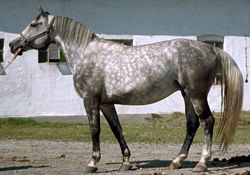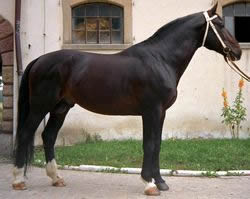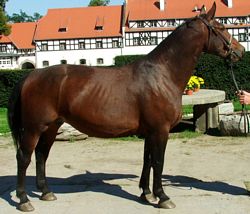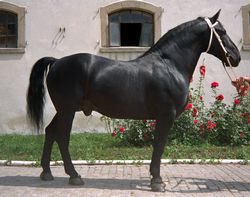Silesian Horses
The breeding of a heavy warmblood horse within the boundaries of German Silesia started at the end of the 19th century, when Oldenburg and East Friesian stallions were introduced to this area in order to create a speedy and sturdy carriage breed useful for both agricultural and army purposes, e.g. in horse artillery. By the Second World War this type of heavy warmblood horse (i.e. calibrated, with a high mass and distinct gaits, strong and balanced) was established in the Silesia region.
both agricultural and army purposes, e.g. in horse artillery. By the Second World War this type of heavy warmblood horse (i.e. calibrated, with a high mass and distinct gaits, strong and balanced) was established in the Silesia region.
A considerable part of the breeding material became extinct or was evacuated during the war; however, it is estimated that about 5,000 Silesian-type horses remained in the territories of Silesia and Lower Silesia. Most of them had no documented pedigree, and the origins of the current Polish breed were selected from amongst them. The mean characteristics of horses from that period were 160 - 201 - 23.4 cm for stallions, and 158.7 – 195.6 – 22.2 cm for mares.
A part of the population was removed from husbandry and aimed at being work horses due to the high demand in 1945 - 1949, and then in 1950 - 1955 as a result of political changes a further part of the population was  reassigned from the breeding to the work population. The plan for the consolidation of the Silesian horse as an agricultural horse was formed in 1956. At that time the average size was 158.5 – 196 – 23.5 cm for stallions and 157 – 193 - 22 cm for mares. The transformation of the breed in the direction of becoming an "economical" horse that was supposed to be a complementary carriage force in mechanized agricultural holdings started in 1964. Concurrently, the addition of the Thoroughbred, Wielkopolski breed and primitive breeds (huculs, konik) was introduced. Strict selection with respect to lowering height led to the elimination of numerous calibrated horses from breeding,
reassigned from the breeding to the work population. The plan for the consolidation of the Silesian horse as an agricultural horse was formed in 1956. At that time the average size was 158.5 – 196 – 23.5 cm for stallions and 157 – 193 - 22 cm for mares. The transformation of the breed in the direction of becoming an "economical" horse that was supposed to be a complementary carriage force in mechanized agricultural holdings started in 1964. Concurrently, the addition of the Thoroughbred, Wielkopolski breed and primitive breeds (huculs, konik) was introduced. Strict selection with respect to lowering height led to the elimination of numerous calibrated horses from breeding, and as a consequence the average characteristics of stallions during the early 1970's were 154 - 193 - 22.5 cm, and 155 - 192 - 21.6 for mares, and individuals of a height of 150 cm or less were often observed. Such small horses appeared to be useless in agriculture, so the breeding plan was changed again in 1969 establishing the desired height at a level of 155 - 158 cm. It was not an easy task, however, since strapping mares rejected from breeding intended as labour animals would have been introduced again as herd mothers; rejected and castrated stallions were lost irreversibly. Still in 1972 the average characteristics of the population were at a level of 156 - 191 - 21.8 cm. The lack of sales caused Silesian horse breeding to become unprofitable and the number of horses decreased rapidly.
and as a consequence the average characteristics of stallions during the early 1970's were 154 - 193 - 22.5 cm, and 155 - 192 - 21.6 for mares, and individuals of a height of 150 cm or less were often observed. Such small horses appeared to be useless in agriculture, so the breeding plan was changed again in 1969 establishing the desired height at a level of 155 - 158 cm. It was not an easy task, however, since strapping mares rejected from breeding intended as labour animals would have been introduced again as herd mothers; rejected and castrated stallions were lost irreversibly. Still in 1972 the average characteristics of the population were at a level of 156 - 191 - 21.8 cm. The lack of sales caused Silesian horse breeding to become unprofitable and the number of horses decreased rapidly.
Interest in Silesian horses returned when in the mid 1970's the Anglo-Silesian half-breeds exported as saddle-horses for heavier riders became popular in Western countries. The popularity of "Polish hunters" caused the massive hybridization of Silesian mares with Thoroughbred getters.
In the late 1970's, there was an increase in interest in the old, heavy type Silesian horse breed. The desired characteristics were established at a level of 160 - 200 - 22 cm. In the mid 1980's four stallion of the Schweres Warmblut breed (heavy warmblood horse)  were brought from Germany with aim of improving the carriage features of Silesian horses. They were taller and of a lighter type, were used on a mass scale, and thus dominated the Polish breeding in less than one decade. The average characteristics of Silesian horses in 1997 were 162.5 – 198 – 22.5 cm. At the same time a programme of conservative breeding was accepted, and the following characteristics for 3-year old horses were established: 158 - 190 - 22.5 cm for mares and 160 - 190 - 23 cm for stallions. In 2000 the final division of the Silesian breed into two types, i.e. an old one aimed at sport carriages and wide-ranging usage, and a new one in a saddle type, was introduced. The desired characteristics, depending on the type, were as follows (cm):
were brought from Germany with aim of improving the carriage features of Silesian horses. They were taller and of a lighter type, were used on a mass scale, and thus dominated the Polish breeding in less than one decade. The average characteristics of Silesian horses in 1997 were 162.5 – 198 – 22.5 cm. At the same time a programme of conservative breeding was accepted, and the following characteristics for 3-year old horses were established: 158 - 190 - 22.5 cm for mares and 160 - 190 - 23 cm for stallions. In 2000 the final division of the Silesian breed into two types, i.e. an old one aimed at sport carriages and wide-ranging usage, and a new one in a saddle type, was introduced. The desired characteristics, depending on the type, were as follows (cm):
| Old type | Height at withers | Chest circumference | Cannon circumference | |
| Mares | 158 - 168 | 190 - 210 | 22.5 - 23.5 | |
| Stallions | 160 - 170 | 23 - 24 | ||
| New type | ||||
| Mares | 162 - 168 | 185 - 200 | 21.5 - 22.5 | |
| Stallions | 164 - 170 | 190 - 200 | 22 - 23 | |
In view of the frequency of breeding programme changes and the concurrent selection based mainly on exterior features, using inter-breed hybridization, it is difficult to rate Silesian horse breeding as a stable one and to expect an even population. However, the analysis of the effects that the subsequent changes led to seems to be an interesting issue.
